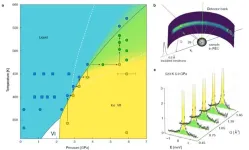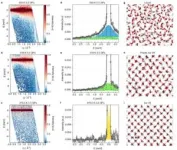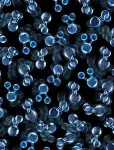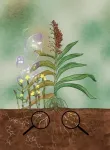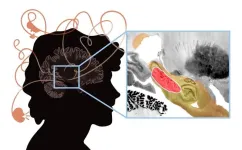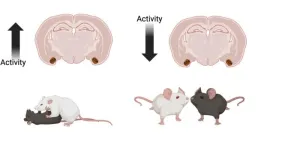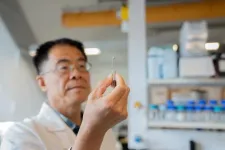Exotic observations with neutrons at the ILL
State-of-the-art neutron spectrometers and sample environment infrastructures at the Institut Laue-Langevin (ILL) have enabled the first experimental observation of an exotic phase of water – plastic ice VII.
2025-02-12
(Press-News.org) In everyday life, we typically encounter water in one of three familiar states – solid, liquid or gas. But there are in fact many more phases, some of which – predicted to exist at high temperature and pressure – are so strange they’re referred to as exotic. State-of-the-art neutron spectrometers and sample environment infrastructures at the Institut Laue-Langevin (ILL) have enabled the first experimental observation of one of these exotic phases – plastic ice VII.
Plastic ice VII was originally predicted more than 15 years ago by molecular dynamics (MD) simulations as a phase of water that could exist under high temperature and pressure. “Plastic phases are hybrid states that blend properties of both solids and liquids,” explains Livia Eleonora Bove, research director at the French National Centre for Scientific Research CNRS, associate professor at La Sapienza University in Rome (Italy) and associated scientist at EPFL – École Polytechnique Fédérale de Lausanne (Switzerland). “In plastic ice, the water molecules form a rigid cubic lattice, as in ice VII, but exhibit picosecond rotational motion reminiscent of liquid water.”
For the study of these fast molecular motions, Quasi-Elastic Neutron Scattering (QENS) is a powerful tool. “The ability of QENS to probe both the translational and rotational dynamics is a unique advantage for the exploration of such exotic phase transitions compared to other spectroscopic techniques,” explains Maria Rescigno, PhD student at Sapienza University and first author of the published study. QENS enabled the identification of three distinct phases as temperature and pressure were varied: liquid water in which both translational and rotational components are present; solid ice where both translational and rotational dynamics are frozen; and the intermediate plastic ice phase where the molecules, arranged in an ordered crystalline structure, have lost the ability to translate freely but have retained the capacity to rotate.
The experiments revealing plastic ice VII were performed using the time-of-flight spectrometers IN5 and IN6-SHARP at the ILL. Temperatures as high as 450 – 600 K and pressures from 0.1 to 6 GPa (up to about 60 thousand times the normal atmospheric pressure) were required to produce this exotic state of water. The implementation of such demanding thermodynamic conditions in neutron spectroscopy was made possible by recent technological advances achieved in collaboration between Bove, CNRS research director Stefan Klotz, and ILL scientist Michael Marek Koza as part of a long-term project at the ILL. "The success of this study relies on the extensive expertise and unique infrastructure built over the years at the ILL, in particular in terms of complex sample environments and high pressures,” underlines Koza, “Additionally, the continuous improvement of ILL's spectrometers – such as those made within the Endurance upgrade programme – has facilitated ever more sophisticated experiments carried out by state-of-the-art instruments,".
A comprehensive analysis of the neutron scattering data also revealed that the molecular dynamics of plastic ice VII could me more intricate than MD simulation had initially predicted. “The QENS measurements suggested a different molecular rotation mechanism for plastic ice VII than the free rotor behaviour initially expected,” explains Rescigno. Additional MD simulations, together with Markov chain analysis, provided a more detailed picture of the water molecule dynamics. A 4-fold rotational model, as typically observed in jump-rotor plastic crystals, was identified as the most likely mechanism.
Further investigations – involving neutron and X-ray diffraction measurements, respectively, on the D20 diffractometer at the ILL and at the Institute of Mineralogy, Physics of Materials and Cosmochemistry (IMPMC) – were carried out to explore the nature of the phase transition from ice VII to plastic ice VII. “This transition is predicted to be either first-order or continuous, depending on the simulation method used,” explains Bove. “The continuous transition scenario is very intriguing as it hints that the plastic phase could be the precursor of the elusive superionic phase – another hybrid exotic phase of water predicted at even higher temperatures and pressures, where hydrogen can diffuse freely through the oxygen crystalline structure.” Both plastic and superionic phases are of high interest in planetary science, with potential implications in our understanding of the internal structure and glacial flow of icy moons like Ganimede and Callisto and icy planets like Uranus and Neptune, where they might dominate.
Neutron scattering hasn’t traditionally been a go-to technique in planetary science. Nevertheless, its unique ability to precisely measure the location and dynamics of hydrogen in a material, combined with the recent possibility of conducting experiments at planetary relevant pressures, has enabled neutron scattering to make a substantial impact in this domain. And there may be more exotic phases yet to uncover.
END
ELSE PRESS RELEASES FROM THIS DATE:
2025-02-12
Scientists have discovered an interaction between genes that increases the risk of developing a type of alopecia.
In a new JAMA Dermatology study, scientists at King’s College London found that changes in two parts of the genome work together to influence alopecia risk.
Frontal fibrosing alopecia (FFA) is a highly distressing dermatological disorder which is associated with inflammation, scarring and irreversible hair loss. The disease affects an increasing number of patients worldwide and is caused by genetic and environmental factors.
The study authors conducted a meta-analysis of four cohorts ...
2025-02-12
Chinese scientists have identified two key genes responsible for sorghum's resistance to Striga, a parasitic plant that causes significant crop losses. The breakthrough, which also highlights the potential of AI to predict key amino acid sites in strigolactone (SL) transporters, could have wide-ranging applications in enhancing parasitic plant resistance across various crops.
This study, published in Cell, was conducted by Prof. XIE Qi's team at the Institute of Genetics and Developmental ...
2025-02-12
Francis Crick Institute press release
Under strict embargo: 16:00hrs GMT Wednesday 12 February 2025
Peer reviewed
Experimental study
Animals, people and cells
Researchers from the Francis Crick Institute have found that some particularly aggressive lung cancer cells can develop their own electric network, like that seen in the body’s nervous system.
This unique property could make them less dependent on the environment surrounding the tumour and even spread more easily.
Small cell lung cancer (SCLC) is one of the hardest types of cancer to ...
2025-02-12
The RNA inhibitor olpasiran significantly reduces a type of “bad cholesterol” that’s associated with a high risk of cardiovascular events, according to results from an analysis by a Mount Sinai researcher of a phase 2 trial. The study reported that higher doses of olpasiran lowered the type of cholesterol called lipoprotein(a) [Lp(a)] by more than 95 percent in participants with atherosclerotic cardiovascular disease. Findings were published February 12, 2025, in JAMA Cardiology.
“Our study is the first clinical trial to investigate the association between oxidized phospholipids on lipoprotein(a) and inflammatory mediators,” says ...
2025-02-12
Andrew Pines, MD, MA, a resident in the Department of Psychiatry at Brigham and Women’s Hospital and a researcher in the Center for Brain Circuit Therapeutics, is the lead author of a paper published in JAMA Psychiatry, Mapping Lesions That Cause Psychosis to a Human Brain Circuit and Proposed Stimulation Target.
Shan Siddiqi, MD, Assistant Professor of Psychiatry at Harvard Medical School and Director of Psychiatric Neuromodulation Research at the BWH Center for Brain Circuit Therapeutics, is the senior author of this ...
2025-02-12
**MEDIA ADVISORY**
UNDER EMBARGO UNTIL: Wednesday, February 12 at 11am EST
Nature article entitled:
A critical role for the cortical amygdala in shaping social encounters
[https://doi.org/10.1038/s41586-024-08540-4]
Bottom Line: Neural activity in the cortical amygdala determines whether mice engage in aggressive or pro-social behavior
Results: By performing a network analysis on whole-brain activity of male mice, we identified the cortical amygdala – an olfactory cortical structure – as a key brain region in promoting aggression. This brain region is activated by olfactory cues from male mice and by aggressive ...
2025-02-12
Recognition of telehealth as an effective strategy for delivering treatment for substance use disorder (SUD) has raised hopes for improving access to this treatment in settings with limited transportation or when time constraints compromise regular use of consistent access to in-person substance use treatment.
But the findings from a team of researchers from the Virginia Center for Health Innovation, UCLA, RAND, and MedInsight, Milliman Inc., suggest that the promise of telehealth may vary by insurance and geography.
New research suggests that people who live ...
2025-02-12
Monash research could transform how broken bones are treated, with the development of a special zinc-based dissolvable material that could replace the metal plates and screws typically used to hold fractured bones together.
Surgeons routinely use stainless steel or titanium, which stay in the body forever, can cause discomfort and may require follow-up surgeries. A new zinc alloy, designed by Monash biomedical engineers, could solve these problems by being mechanically strong but gentle enough to degrade safely over time while supporting optimal healing.
A study published today in Nature shows the research team’s innovative ...
2025-02-12
An increase in high-fat, high-fructose foods in people’s diets has contributed to a dramatic increase in type 2 diabetes. This, in turn, has led to an increase in peripheral neuropathy — nerve damage, typically in the hands and feet — that causes weakness, loss of sensation and, in some, a stabbing, burning, or tingling pain. About half of people with type 2 diabetes are affected, and of these, about half experience severe neuropathic pain.
The damage begins as axons from sensory neurons begin to retract and disappear from the tissues they innervate. New research from the lab of Clifford Woolf, MB, BCh, PhD, director ...
2025-02-12
A research team led by Professor WANG Min from the Institute of Vertebrate Paleontology and Paleoanthropology (IVPP) of the Chinese Academy of Sciences has discovered two bird fossils in Jurassic-era rocks from Fujian Province in southeast China. These rocks date back approximately 149 million years. The fossils fill a spatiotemporal gap in the early evolutionary history of birds and provide the evidence yet that birds were diversified by the end of the Jurassic period.
This study was published in Nature.
Birds ...
LAST 30 PRESS RELEASES:
[Press-News.org] Exotic observations with neutrons at the ILL
State-of-the-art neutron spectrometers and sample environment infrastructures at the Institut Laue-Langevin (ILL) have enabled the first experimental observation of an exotic phase of water – plastic ice VII.
